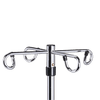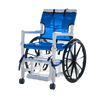Helpful Articles

Tips to Manage Acid Reflux for Seniors 0
As we age, managing acid reflux becomes essential for maintaining comfort and overall well-being. In this blog post, we'll explore practical tips to help seniors effectively handle acid reflux symptoms. Join us in discovering straightforward strategies for a more comfortable lifestyle.- Dansons Medical Support

Recognizing Early Signs of UTIs 0
As we age, understanding and promptly addressing potential health concerns become paramount. In this blog post, we'll delve into the early warning signs of Urinary Tract Infections (UTIs) among seniors. Join us in learning how to identify these signs early for better health outcomes.- Dansons Medical Support

Essential Tips for Seniors to Prevent Bed Sores 0
As we age, maintaining comfort and preventing health issues become paramount. In this blog post, we'll explore essential tips to detect and avoid bed sores, providing seniors with practical guidance for a more comfortable and healthier life. Join us on this journey to ensure the well-being of our beloved seniors.- Dansons Medical Support

Bridging the Distance: Innovative Ways to Care for Loved Ones Remotely 0
In an era defined by geographical separation, our ability to care for loved ones from a distance has become increasingly important. With the aid of modern technology and innovative services, we can bridge the physical gap and ensure the well-being of those we cherish, even when miles apart. This guide highlights practical ways to provide care and support to loved ones from afar, ensuring their well-being and peace of mind.- Dansons Medical Support


 Lifts
Lifts
 Patient Lifts
Patient Lifts
 Stand Assists
Stand Assists
 Standing Aids
Standing Aids
 Slings
Slings
 Parts & Accessories
Parts & Accessories
 Wheelchairs
Wheelchairs
 Ergonomic
Ergonomic
 Portable
Portable
 Reclining
Reclining
 Standing
Standing
 Sporting
Sporting
 Bariatric
Bariatric
 Ramps
Ramps
 Modular
Modular
 Portable
Portable
 Parts & Accessories
Parts & Accessories
 Walking Aids
Walking Aids
 Rollator Walkers
Rollator Walkers
 Canes
Canes
 Crutches
Crutches
 Parts & Accessories
Parts & Accessories
 Scooters
Scooters
 4-Wheel
4-Wheel
 Folding
Folding
 Parts & Accessories
Parts & Accessories
 Nursing
Nursing
 Pregnancy Comfort
Pregnancy Comfort
 Self-Care
Self-Care
 Pump Parts
Pump Parts
 Exercise Equipment
Exercise Equipment
 Treadmills
Treadmills
 Walking Pads
Walking Pads
 Rowing Machines
Rowing Machines
 Strength & Conditioning
Strength & Conditioning
 Massage Chairs
Massage Chairs
 Saunas
Saunas
 Hot & Cold Tubs
Hot & Cold Tubs
 Stethoscopes
Stethoscopes
 Surgical Instruments
Surgical Instruments
 Forceps
Forceps
 Scalpels
Scalpels
 IV Poles
IV Poles
 Oxygen
Oxygen
 Beds
Beds
 Electric Beds
Electric Beds
 Standing Beds
Standing Beds
 Mattresses
Mattresses
 Bed Accessories
Bed Accessories
 Bed Parts
Bed Parts
 Chairs
Chairs
 Medical Recliners
Medical Recliners
 Phlebotomy Chairs
Phlebotomy Chairs
 Stools & Task Chairs
Stools & Task Chairs
 Parts & Accessories
Parts & Accessories
 Tables
Tables
 Overbed Tables
Overbed Tables
 Medical Tables
Medical Tables
 Recovery Couches
Recovery Couches
 Cabinets
Cabinets
 Pool
Pool
 Pool Lifts
Pool Lifts
 Pool Fitness & Therapy
Pool Fitness & Therapy
 Pool Access Chairs
Pool Access Chairs
 Slings
Slings
 Parts & Accessories
Parts & Accessories
 Bath
Bath
 Toileting Aids
Toileting Aids
 Bath Lifts
Bath Lifts
 Shower Seats
Shower Seats
 Parts & Accessories
Parts & Accessories
 Portable Shower
Portable Shower
 Dansons Products
Dansons Products
 Transfer Aids
Transfer Aids
 Cushions
Cushions
 eBooks
eBooks
 Helpful Articles
Helpful Articles
 Reviews
Reviews
 Contact Us
Contact Us
 Create Account
Create Account
 Request a Quote
Request a Quote
